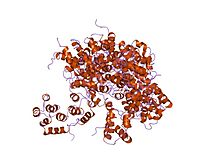CARD domain
| Caspase recruitment domain | |||||||||
|---|---|---|---|---|---|---|---|---|---|

Structure of the RAIDD CARD.
|
|||||||||
| Identifiers | |||||||||
| Symbol | CARD | ||||||||
| Pfam | PF00619 | ||||||||
| InterPro | IPR001315 | ||||||||
| SMART | SM00114 | ||||||||
| PROSITE | PS50209 | ||||||||
| SCOP | 3crd | ||||||||
| SUPERFAMILY | 3crd | ||||||||
| CDD | cd01671 | ||||||||
|
|||||||||
| Available protein structures: | |
|---|---|
| Pfam | structures |
| PDB | RCSB PDB; PDBe; PDBj |
| PDBsum | structure summary |
Caspase recruitment domains, or Caspase activation and recruitment domains (CARDs), are interaction motifs found in a wide array of proteins, typically those involved in processes relating to inflammation and apoptosis. These domains mediate the formation of larger protein complexes via direct interactions between individual CARDs. CARD domains are found on a strikingly wide range of proteins, including helicases, kinases, mitochondrial proteins, caspases, and other cytoplasmic factors.
CARD domains are a subclass of protein motif known as the death fold, which features an arrangement of six to seven antiparallel alpha helices with a hydrophobic core and an outer face composed of charged residues. Other motifs in this class include the pyrin domain (PYD), death domain (DD), and death effector domain (DED), all of which also function primarily in regulation of apoptosis and inflammatory responses.
CARD domains were originally characterized based on their involvement in the regulation of caspase activation and apoptosis. The basic six-helix structure of the domain appears to be conserved as far back as the ced-3 and ced-4 genes in C. elegans, the organism in which several components of the apoptotic machinery were first characterized. CARD motifs are present on a number of proteins that promote apoptosis, primarily caspases 1,2,4,5,9, and 15 in mammals.
A number of CARD proteins have been shown to play a role in regulating inflammation in response to bacterial and viral pathogens as well as to a variety of endogenous stress signals. Recently, studies on the NLR protein Ipaf-1 have provided insight into how CARD proteins participate in the immune response. Ipaf-1 features an N-terminal CARD domain, a nucleotide-binding domain, and C-terminal leucine-rich repeats (LRRs), thought to function in a similar fashion to those found in Toll-like receptors. The primary role of this molecule appears to be regulation of the proteolytic processing of pro-IL-1β and pro-IL-18 into their mature forms via association in a large complex known as the inflammasome. Upon activation of Ipaf-1 by the intracellular bacterium S. typhimurium or other stress signals, Ipaf-1 recruits a CARD-containing adapter termed ASC and caspase-1 in unknown stoichiometry via CARD-CARD association. This complex in turn leads to autoproteolytic activation of caspase-1 and subsequent IL-1β and IL-18 maturation.
...
Wikipedia
